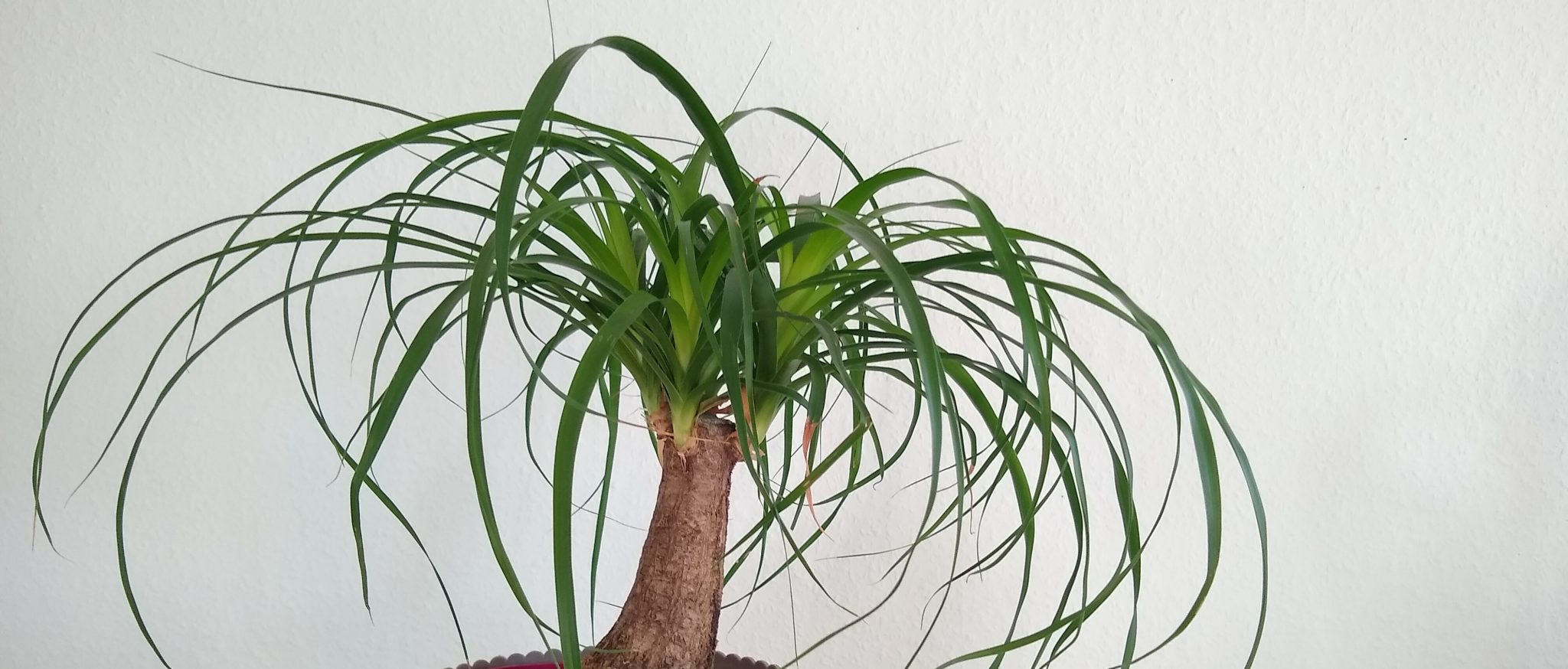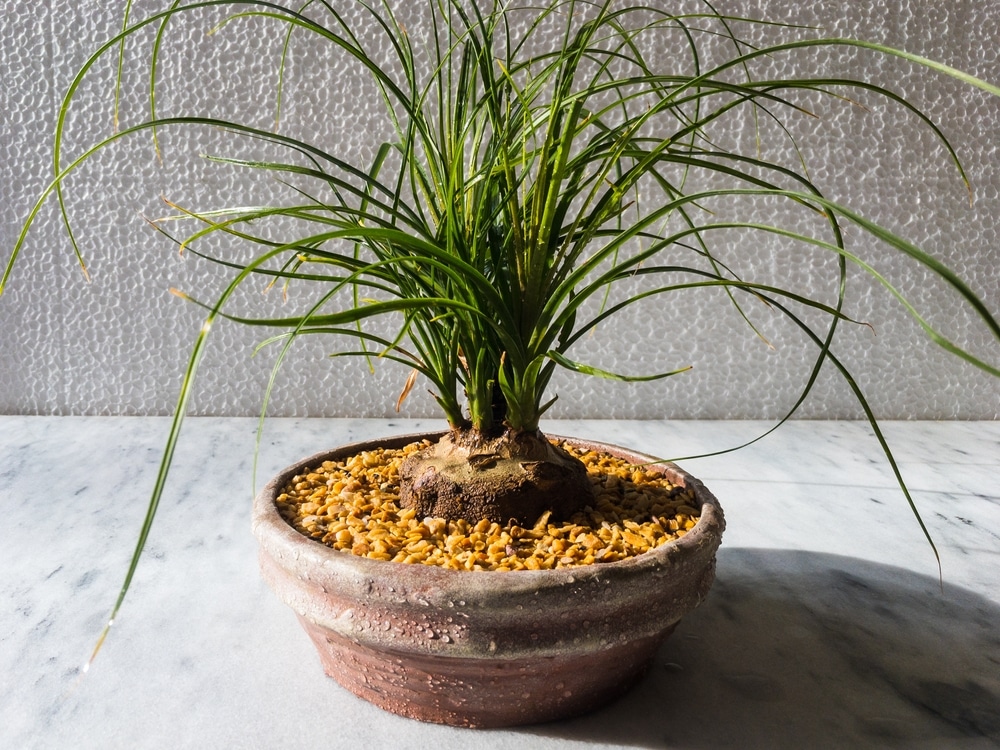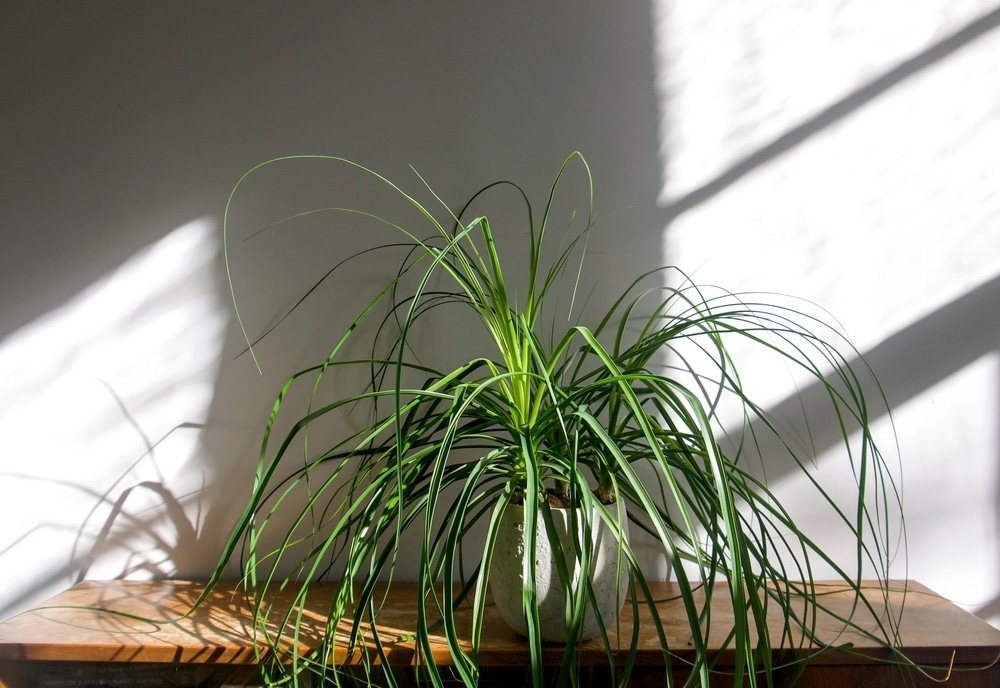Ponytail Palm is a unique-looking plant from the genus Beaucarnea or Nolina. This plant is a popular house plant because of its lush, slick, curly leaves and bulb-like trunk, which gives a stunning visual appeal to any space. In addition to its captivating look, gardeners named this plant the “Elephant foot tree” because it resembled the animal’s bulky legs.
| Botanical Name | Beaucarnea recurvata |
| Common Name | Elephant Foot Tree and Bottle Palm Tree |
| Plant Type | Perennial |
| Flower Color | White or Yellow |
| Size When Mature | 10 inches when potted, 20 inches when matured on direct soil. |
| Bloom Time | Spring or Summer |
| Sun Requirements | Full sun, Partial Sun |
| USDA Hardiness Zones | 8-11 but will thrive in any zones when grown indoors. |
| Soil PH Range | pH 6.5 to 7.5 |
| Soil Type | Fast-draining |
| Water Needs | Low |
| Native Area | Mexico |
What You Need to Know About Ponytail Palm
Also known as the bottle palm tree, you might be surprised that it is succulent because it can store water in its thick trunk. This plant is native to Mexico and can grow up to 20 feet tall, but when grown in containers, it only reaches a height of 6-10 feet.
It has a slow growth rate, which makes it perfect for people who do not have the patience to wait for their plants to grow.
How to Care for Ponytail Palm
Here’s everything you need to know about growing and caring for a thriving ponytail palm.
Light
As a succulent, ponytail palm prefers bright and indirect sunlight. It can tolerate some direct sun, but not for too long as it may cause the leaves to scorch and turn brown. If you are growing your ponytail palm indoors, place it near a bright window and rotate the pot to ensure that all sides of the plant get equal sunlight light.
If you are located in a hot climate, it is best to grow your ponytail palm in dappled sunlight or partial shade to protect it from the harsh midday sun.
Water and Soil Needs
This succulent plant does not require much when it comes to soil, but it prefers a soil pH of 6.0-7.5. A well-draining cactus mix or potting soil with equal parts perlite and sand mix will work perfectly.
The ponytail palm is a drought-tolerant plant, so it does not need to be watered often. Overwatering is one of the main reasons why this plant dies. When you water your plant, ensure to give it a good soak until water runs out of the drainage holes. Then, let the soil dry out completely before watering again. Depending on the temperature and humidity, this could be every 2-4 weeks.
If you are planning to plant it in a warm climate, you might need to water your ponytail palm more often during summer. If you are not sure when to water, always err on the side of underwatering rather than overwatering.
Temperature Requirements
The Ponytail Palm can survive in zones 8-11 but will thrive in any climate zone when grown indoors. A room temperature between 60-85°F is ideal for this plant. It can tolerate colder temperatures until 50°F, but it will go into dormancy and stop growing.
If you are in a colder climate, you can move your ponytail palm indoors during winter to protect it from the cold weather.
Fertilizer
Ponytail palms are slow-growing plants, so they do not need a lot of fertilizer. Too much fertilizer can do more harm than good. If you decide to fertilize your plant, use a succulent fertilizer or diluted all-purpose fertilizer and apply it every 2-3 months during the growing season. Be sure to follow the directions on the label, because too much fertilizer can burn the roots of your plant.
Common Diseases
Mealybugs are tiny bugs that can attach to a ponytail palm and suck the sap out. This will cause the leaves to turn yellow and drop off. If you see mealybugs on your plant, remove them with a cotton swab dipped in rubbing alcohol. You can also use insecticidal soap or neem oil to take them off the plant.
Bottle palm trees are also susceptible to root rot caused by overwatering. If you notice that the leaves of your plant are turning yellow and dropping off, check if the roots are mushy or black. If they are, your plant is likely suffering from root rot. An effective way to treat this disease is by removing the affected roots and replanting them in new, well-draining soil.
How Big Does a Ponytail Palm Get
The ponytail palm is a unique plant that can make an interesting addition to any indoor or outdoor space. When grown outdoors, it can reach up to 20 feet tall, however, if you are thinking of giving its own little space, it is important to know that the plant only gets about 3-5 feet tall.
Ponytail palms are slow growers, so if you want your plant to reach its full potential, be patient and give it time. With proper care, your ponytail palm will continue to grow for many years.
Ponytail Palm Propagation
Gardeners love the ponytail palm in their gardens and inside their homes for two reasons. The first reason is, that this plant is low maintenance and does not require too much attention to thrive. The second reason is that it is easy to propagate, therefore, you can make as many ponytail palms as you like.
Propagating Ponytail Palm Shoots
When a ponytail palm begins to grow new pups, it can be propagated by splitting the pup away from the mother plant and replanting it in a pot of soil.
Materials needed:
- Ponytail palm (Beaucarnea recurvata)
- Cactus soil mix or potting soil
- Perlite
- Sand
- Rubbing alcohol
- Insecticidal soap
- Neem oil
- Pot
- Knife
Instructions:
Wait until the ponytail palm pup is big enough to handle before attempting to propagate it. You will know it is ready when the leaves are long and stiff or once it reaches 4 inches in height.
Using a sharp knife, gently cut the pup away from the mother plant, being sure to get as much of the root ball as possible. Next, remove leaves from the bottom of the pup to create a stem-like base.
After successfully cutting the pup, let it dry for a day to let the “wound” heal. If the plant is potted too early, there is a higher chance of root rot.
Fill a pot with cactus soil mix or potting soil and add perlite, sand, and organic matter to help with drainage. Place the ponytail palm in the pot and water it lightly.
Move the plant to an area that receives bright, indirect sunlight and keep the soil moist but not wet. After a few weeks, you should see new growth.
Ponytail Palm Repotting
When the plant outgrows its pot, it will need repotting to continue growing healthy and strong. The best time to repot a ponytail palm tree is in the spring when the plant is just beginning to enter its active growing phase. However, repotting can be done at any time of year if necessary. Here are the steps for repotting a ponytail palm:
- Choose a pot that is only slightly larger than the current pot preferably 2-3 inches wider than its previous growing area. A pot that is too large will result in the roots becoming waterlogged and may cause the plant to become susceptible to root rot.
- Use a well-draining potting mix formulated for succulents. If unsure, you can create your mix by blending equal parts of peat moss, sand, and perlite.
- Water the plant thoroughly a few hours before repotting to help make the roots easier to work.
- Gently remove the plant from its current pot and brush away any old potting mix clinging to the roots.
- Place the succulent in the new pot and fill it around it with fresh potting mix. Tamp down the soil lightly to secure it in place.
- Water the plant thoroughly and place it in a bright, warm location.


